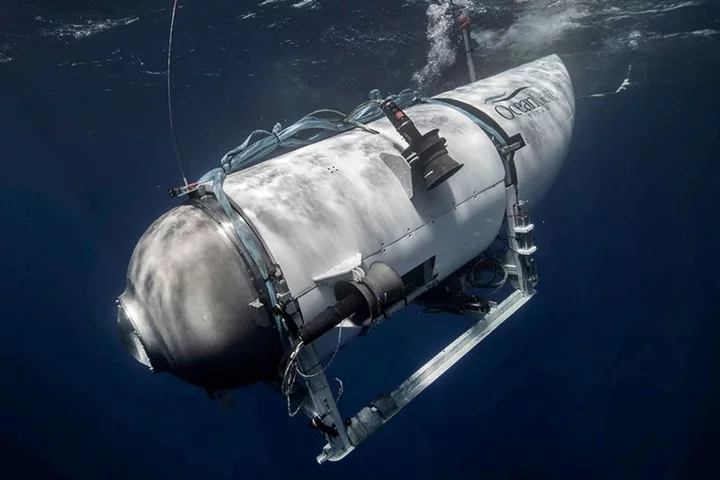By Joseph Ax and Steve Gorman
(Reuters) -Relatives and colleagues mourned on Friday five people who died when their submersible imploded in the North Atlantic during a deep dive to the Titanic wreck, triggering questions about safety rules for such adventures into the ocean depths.
Debris from the Titan submersible, missing since Sunday, was detected on Thursday by a robotic diving vehicle deployed from a Canadian ship as part of an international rescue effort.
Remains of the submersible, which lost contact with a surface ship about 1 hour and 45 minutes into a 2-hour descent, were discovered on the seabed about 1,600 feet (488 meters) from the bow of Titanic wreck, about 2-1/2 miles (4 km) below the surface , U.S. Coast Guard Rear Admiral John Mauger said.
He told reporters on Thursday the debris was consistent with "a catastrophic implosion of the vehicle."
The five who died included Stockton Rush, U.S. founder and chief executive of OceanGate Expeditions, which operated the submersible and charged $250,000 per person to make the Titanic trip. He was piloting the craft.
The others were British billionaire and explorer Hamish Harding, 58; Pakistani-born businessman Shahzada Dawood, 48, and his 19-year-old son, Suleman, both British citizens; and French oceanographer and Paul-Henri Nargeolet, 77.
"These men were true explorers who shared a distinct spirit of adventure, and a deep passion for exploring and protecting the world's oceans," OceanGate said.
A statement issued by the British Asian Trust on behalf of the Dawood family read: "We mourn the tragic loss of Shahzada and his beloved son, Suleman, who had embarked on a journey to visit the remnants of the legendary Titanic."
British Titanic explorer Dik Barton paid tribute to his friend Nargeolet but noted issues raised with the design and maintenance of the craft. "Everyone's wise after the event, but as we're hearing before, unfortunately there were many red flags flying here," he said.
Questions about Titan's safety were raised in 2018 during a symposium of submersible industry experts and in a lawsuit by OceanGate's former head of marine operations, which was settled later that year.
Guillermo Söhnlein, the co-founder of OceanGate who left in 2013, defended Rush and his determination to build a safe craft.
"Stockton was one of the most astute risk managers I'd ever met. He was very risk-averse. He was very keenly aware of the risks of operating in the deep ocean environment, and he was very committed to safety," Söhnlein told Reuters.
INTERNATIONAL EFFORT
Worldwide media coverage of the search overshadowed the aftermath of a far greater disaster from the wreck of a migrant vessel off Greece last week that killed hundreds of people.
Teams from the U.S., Canada, France and Britain had spent days scanning a vast swathe of open sea for the Titan.
The U.S. Coast Guard's Mauger said it was too early to say when the Titan met its fate.
But the position of debris relatively close to the wreck suggested it happened near the end of Sunday's descent.
The U.S. Navy said an analysis of acoustic data detected "an anomaly consistent with an implosion or explosion" near the submersible's location when communication with Titan was lost.
A senior Navy official said in a statement first quoted by the Wall Street Journal that its information "while not definitive" was shared with commanders of the search mission.
The Journal, citing unnamed U.S. defense officials, said the sound was picked up by a system used to detect enemy submarines.
Moviemaker James Cameron, who directed the 1997 Oscar-winning film "Titanic" that did much to revive global interest in the British ocean liner that sank in 1912, said he learned of the acoustic findings within a day and knew what it meant.
"I sent emails to everybody I know and said we've lost some friends. The sub had imploded," Cameron, who has ventured to the wreck in submersibles, told Reuters.
He said he had sent those emails on Monday
"There may be calls for more regulation, better understanding of how these sorts of vehicles are designed, built and certified for use in these deep sea environments," said Stefan Williams, professor of marine robotics at the University of Sydney.
Scientist and journalist Michael Guillen, who survived an expedition in 2000 that became trapped in the wreck's propeller, said: "We need to stop, pause and ask this question, why do you want to go to the Titanic and how do you get there safely?"
The Titanic sank after hitting an iceberg on its first voyage, killing more than 1,500 people aboard. It lies about 900 miles (1,450 km) east of Cape Cod, Massachusetts, and 400 miles (640 km) south of St. John's, Newfoundland.
(Reporting by Joseph Ax and Steve Gorman; Additional reporting by Charlotte Greefield and Reuters bureaus; Editing by Edmund Blair and Andrew Cawthorne)

